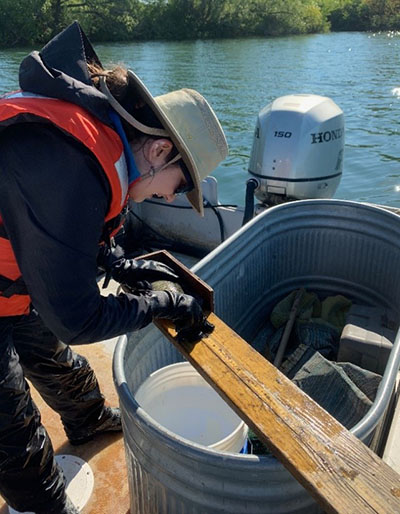Meet Our Graduate Students!

Katelyn Barhite (MS candidate)
After a stint as the TIBS lab manager, Katelyn transitioned to an MS program in fisheries science at ESF. She is developing research related to improved management of the river’s fisheries and will focus on double-crested cormorant predation effects. Historically, cormorants were determined to have significant impacts on fish. When round goby became abundant in the mid-2000s, it was determined that cormorant diet switched to this invasive species and buffered other native fish species from impact. Katelyn will re-evaluate this process and determine if it is still operating since round goby have now been in the system for over 15 years.

Anna Conklyn (PhD candidate)
Congratulations to Anna for passing her doctoral candidacy exam this past spring. Anna also taught Limnology in fall 2020 as the sole instructor. She continues her research on the relationships between the life history of the invasive round goby, the physical environment, and Viral Hemorrhaging Septicemia Virus (VHSV), for which the goby is a prominent vector. Anna is conducting this work with Dr. Farrell in muskellunge spawning and nursery sites where VHSV and round goby are believed to have caused a significant mortality event beginning in the mid-2000s. VHSV is known to have mutated and numerous viral variants are present in the ecosystem. Research partners include Dr. Rod Getchell of the Cornell Veterinary College who assists Anna with qPCR tests and analysis of sequence variants that she is using in her research.

Amanda Lemoine (MS candidate)

Thornton Ritz (PhD candidate)
We welcome Thornton Ritz who will be studying hypoxia in wetlands of the St. Lawrence River. Thornton joins us from Northern Michigan University where he studied larval ecology of the burbot for his MS degree program. Be sure to check out the Student Spotlight for a deep dive into Thornton’s research and what he is finding.

Iman Pakzad (MS graduate)
Congratulations to Iman who graduated in May 2021 and is now a TIBS alum! Iman completed her Master’s study of a diet and trophic niche and mercury bioaccumulation comparison of two invasive fish – the round goby and tubenose goby. She did this work with advisors Drs. Roxanne Razavi and John Farrell. It is surprising that tubenose goby gained a foothold in the river benthic food web while round goby are so dominant and native benthic species have declined to near extirpation. Iman’s work sheds light on coexistence of these two invasive species. It is even possible that round goby may facilitate tubenose goby. Iman is now working for the USGS Lake Ontario Biological Station in Oswego NY.

Max Wilder (PhD candidate)
From ESF Professor Dr. Hyatt Green’s microbiology lab, Max is testing an eDNA assay for muskellunge he developed in 2019. This assay can be used to detect muskellunge without netting or handling and is hoped to aid in better understanding its distribution in the river. Environmental DNA (eDNA) is a method where genetic material that is continually being shed by organisms can be sampled in the environment and detected using molecular tools including primers and amplification. To validate this procedure, Max conduced an experiment at the Mark A. F. Baker Aquatic Laboratory at TIBS, by measuring DNA shed during the early development of muskellunge, from the embryo through juvenile stage. He will apply the method in field sites as part of the muskellunge recovery program.